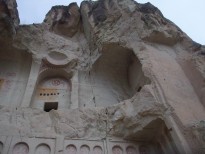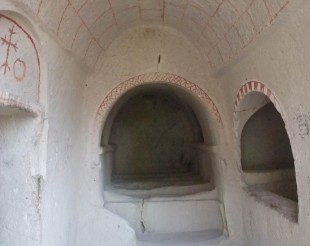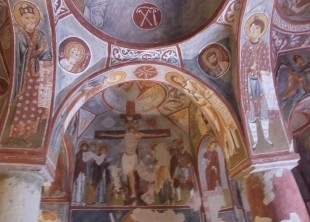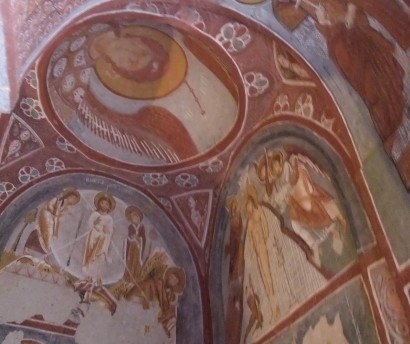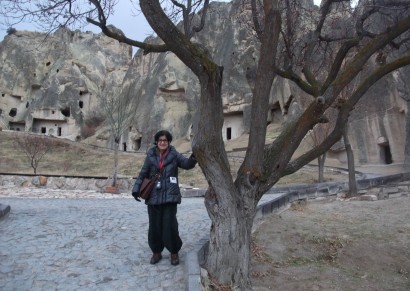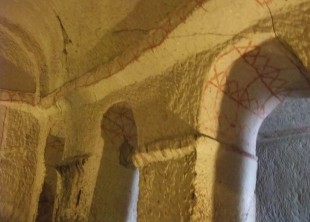Yilanli Church (Saint Onuphrius
Eglise Yilanli (Saint Onuphrius)

11th century Church / Eglise du 11ème siècle

Church is in the rectangular plan, in the barrel vault. It remained unfinished.
On each side of the vault is the Saints respected in Cappadoce
In front of the entrance, the Jesus holding the Bible in the left hand
Eglise au plan rectangulaire, à la voute en berceau. Elle est restée inachevée.
De chaque côté de la voute se trouve les Saints respectés de Cappadoce
Face à l’entrée, Jésus tenant la Bible dans sa main gauche

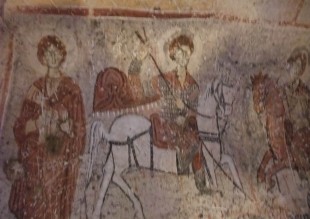 On the East of the vault there are Saint Onesimus, Saint Georges and Saint Theodore killing the dragon, Saint Helena with her son Constantin holding the real cross
On the East of the vault there are Saint Onesimus, Saint Georges and Saint Theodore killing the dragon, Saint Helena with her son Constantin holding the real cross
A l’est de la voûte Saint Onesimus, Saint Georges et Saint Théodore tuant le dragon, Sainte Hélène avec son fils Constantin tenant la vraie croix
In a representation painted on the West by the vault is Saint Onuphrius, naked and having of length hair. He is behind a palm tree. Near him blessing Saint Thomas and Saint Basile holding the Codex in the hand
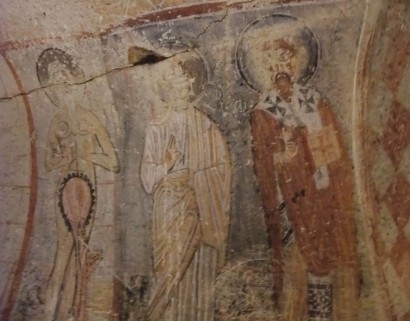
Dans une représentation peinte à l’ouest de la voûte se trouve Saint Onuphrius, nu et ayant de long cheveux. Il est derrière un palmier. Près de lui Saint Thomas bénissant et Saint Basile tenant le Codex dans sa main.
In 1st century before Christ, in the Egyptian desert people withdrew far from the world to dedicate itself only to the prayer; we called them hermits.
The hermit Saint Onuphrius of Thebes (Egypt) whose holiday is celebrated on June 12th, had begun his religious life in a monastery Cenobitique in the neighbourhood of Hermopolis. Onuphrius believing that hermit's life was preferable in the community life withdrew in the desert.
In 4th century, Saint Paphnutios, the last hermit, to know better the life of the isolated hermits, left in the Egyptian desert and got acquainted of Saint Onuphrius. During more than 60 years Onuphrius survived by feeding only on dates and on roots of plants.
Au 1er siècle avant Jésus Christ, dans le désert égyptien des hommes se retiraient loin du monde pour se consacrer uniquement à la prière ; on les appelait des ermites.
L’ermite Saint Onuphrius de Thèbes (Egypte) dont la fête est célébrée le 12 juin, avait commencé sa vie religieuse dans un monastère Cénobitique aux environs d’Hermopolis. Onuphrius croyant que la vie d’ermite était préférable à la vie communautaire se retira dans le désert.
Au 4ème siècle, Saint Paphnutios, le dernier ermite, afin de mieux connaître la vie des ermites isolés, partit dans le désert égyptien et fit la connaissance de Saint Onuphrius. Pendant plus de 60 années Onuphrius survécut en se nourrissant uniquement de dattes et de racines de plantes.
Landscape in the dimming day!
Paysage au jour baissant !

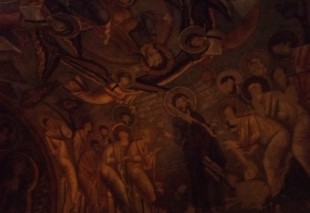
 To visit this church there it was necessary to pay a special entrance fee; but it was worth it!
To visit this church there it was necessary to pay a special entrance fee; but it was worth it!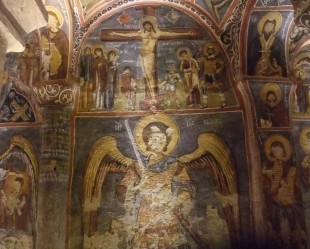 Pour visiter cette église là il a fallu payer un droit d’entrée spécial; mais ça en valait la peine!
Pour visiter cette église là il a fallu payer un droit d’entrée spécial; mais ça en valait la peine!
